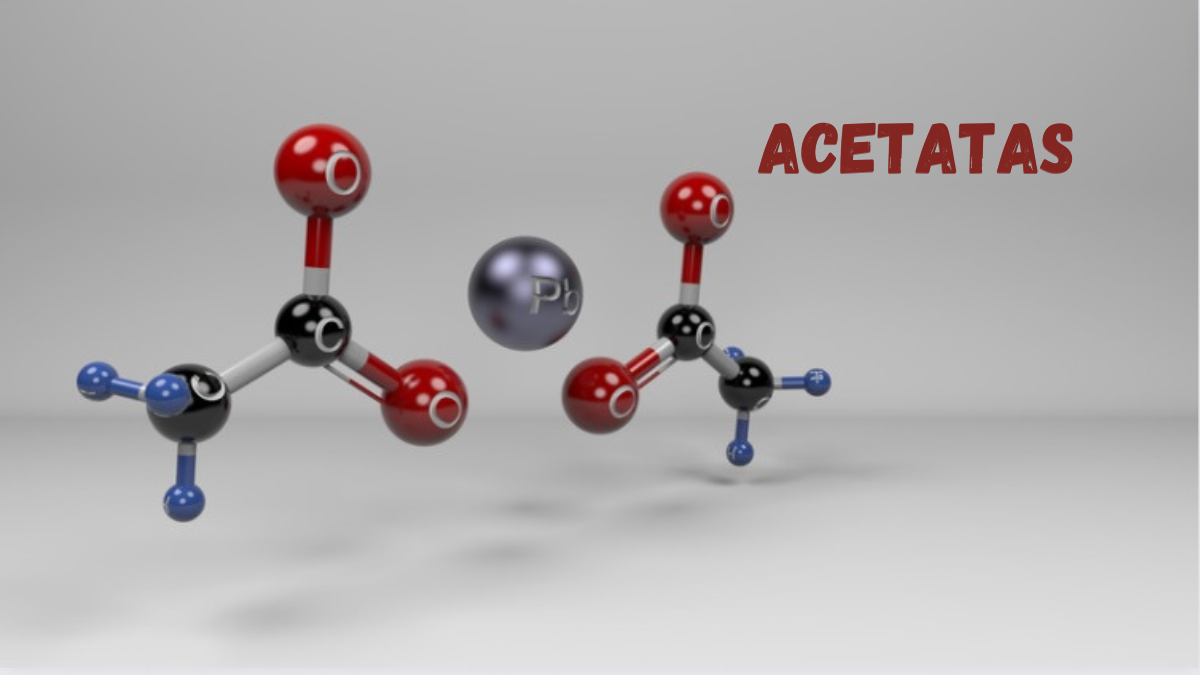Education
Understanding Acetatas: The Essential Guide

Introduction
Acetatas might not be a household name, but they play a crucial role in many industries and applications. So, what exactly are acetatas, and why are they important? This guide will take you through the fascinating world of acetatas, exploring their history, types, properties, applications, and much more.
History of Acetatas
Early Discovery
The journey of acetatas began centuries ago when early chemists discovered various acetate compounds. These discoveries laid the foundation for understanding acetatas and their diverse applications.
Evolution of Use
Over time, the use of acetatas has evolved significantly. Initially used in basic chemical reactions, they have now found applications in industries ranging from textiles to pharmaceuticals.
Types of Acetatas
Common Types
Acetatas come in several forms, each with unique properties and uses. Some of the most common types include methyl acetate, ethyl acetate, and butyl acetate.
Industrial Acetatas
In industrial settings, acetatas are invaluable. They are used as solvents in the production of paints, coatings, and adhesives, showcasing their versatility and effectiveness.
Medical Acetatas
In the medical field, acetatas are used in various formulations, including pharmaceuticals and medical-grade solvents, due to their relatively low toxicity and effective solvent properties.
Chemical Properties
Molecular Structure
The molecular structure of acetatas is simple yet effective. Typically, they consist of an acetate group bonded to various organic groups, contributing to their unique characteristics.
Physical Properties
Acetatas are generally known for their volatility and pleasant fruity odors. These physical properties make them ideal for use in perfumes and flavorings.
Production Methods
Natural Production
Some acetatas occur naturally in fruits and other organic materials, contributing to their distinctive smells and flavors.
Synthetic Production
Synthetic production methods involve chemical reactions between acetic acid and alcohols. These methods are highly efficient and can produce large quantities of acetatas for industrial use.
Applications of Acetatas
Industrial Applications
In the industrial sector, acetatas are primarily used as solvents. They dissolve a wide range of substances, making them essential in the production of paints, coatings, and adhesives.
Medical Applications
Acetatas are also used in the medical field. They serve as solvents in pharmaceuticals and are involved in the synthesis of various drugs.
Everyday Uses
In everyday life, acetatas are found in products like nail polish removers, perfumes, and flavorings. Their pleasant smell and effective solvent properties make them popular in these applications.
Benefits of Acetatas
Environmental Benefits
Many acetatas are biodegradable, which means they break down naturally in the environment. This reduces their impact on pollution compared to other synthetic chemicals.
Economic Benefits
The versatility and effectiveness of acetatas make them cost-effective solutions in various industries. Their ability to replace more expensive or hazardous solvents is a significant economic advantage.
Health and Safety
Safe Handling
While acetatas are generally safe, handling them with care is essential. Using appropriate protective equipment and working in well-ventilated areas can prevent potential health issues.
Potential Risks
Despite their benefits, acetatas can pose risks if not handled properly. Inhalation or prolonged skin contact can cause irritation, so it’s crucial to follow safety guidelines.
Environmental Impact
Biodegradability
One of the significant advantages of acetatas is their biodegradability. They break down into harmless substances, reducing their environmental footprint.
Pollution Concerns
However, improper disposal of acetatas can lead to pollution. Ensuring proper disposal methods can mitigate these concerns and protect the environment.
Future Trends
Innovations in Production
The future of acetatas looks promising, with ongoing research focusing on more sustainable and efficient production methods. Innovations in biotechnology may lead to even greener production processes.
Emerging Applications
New applications for acetatas are continually being discovered. From advanced materials to innovative medical treatments, the potential uses for acetatas are expanding.
Acetatas in Everyday Life
Common Products Containing Acetatas
You might not realize it, but acetatas are all around us. They are found in everyday products like cosmetics, cleaning agents, and even some food items.
Tips for Use and Disposal
When using products containing acetatas, always follow the manufacturer’s instructions. For disposal, check local guidelines to ensure you’re not harming the environment.
Comparisons with Similar Compounds
Differences Between Acetatas and Acetates
While they sound similar, acetatas and acetates are different. Acetates are salts or esters of acetic acid, whereas acetatas refer to a broader group of related compounds.
Acetatas vs. Other Esters
Compared to other esters, acetatas often have more favorable properties, such as lower toxicity and better biodegradability, making them preferable in many applications.
Scientific Research
Recent Studies
Recent studies have focused on improving the production processes of acetatas and exploring new applications. These studies aim to make acetatas more efficient and environmentally friendly.
Ongoing Research
Ongoing research is looking into the potential health benefits and risks associated with acetatas. Understanding these factors is crucial for their safe and effective use.
Regulations and Standards
Global Standards
Several global standards regulate the production and use of acetatas, ensuring their safety and effectiveness. These standards help maintain quality and protect users.
Regulatory Bodies
Organizations like the FDA and EPA oversee the regulation of acetatas in the United States. Their guidelines ensure that acetatas are used safely in various applications.
Conclusion
Acetatas are versatile compounds with a wide range of applications. From industrial uses to everyday products, they play an essential role in our lives. Understanding their properties, benefits, and potential risks is crucial for their safe and effective use. As research and innovation continue, the future of acetatas looks promising, with new applications and improved production methods on the horizon.
What are acetatas?
Answer:
Acetatas are a group of compounds commonly used as solvents in various industrial, medical, and everyday applications.
How are acetatas produced?
Answer:
Acetatas can be produced naturally or synthetically, typically through reactions between acetic acid and alcohols.
What are the benefits of using acetatas?
Answer:
Acetatas offer several benefits, including biodegradability, cost-effectiveness, and versatility in various applications.
Are there any risks associated with acetatas?
Answer:
While generally safe, acetatas can cause irritation if inhaled or in contact with skin. Proper handling and safety measures are essential.
How can I safely dispose of products containing acetatas?
Answer:
Follow local guidelines for disposal to ensure that products containing acetatas do not harm the environment.
Education
Elise Dang Ccedla Tips for Success

Success in any professional or educational environment often begins with inspiration and practical advice from those who have already paved the way. Elise Dang Ccedla, a standout alumni from the CCEDLA (Community College Entrepreneurial Development Leadership Academy), exemplifies this principle. Known for her remarkable achievements within the CCEDLA community, Elise has become a guiding light for aspiring entrepreneurs, CCEDLA students, and business enthusiasts.
From navigating the challenges of a competitive program to developing innovative entrepreneurial strategies, Elise’s journey holds invaluable lessons. This blog dives deep into her path to success and offers her top tips for excelling in the CCEDLA program and beyond. Whether you’re planning to launch a business, refine your leadership skills, or simply grow within the business world, you’ll find actionable insights here.
Understanding Success at Elise Dang Ccedla
The CCEDLA program is at the forefront of entrepreneurial and business education, providing a robust platform for students to grow both academically and professionally. Designed to hone leadership, problem-solving, and business acumen, CCEDLA encourages participants to think creatively and push boundaries.
However, participating in such a dynamic program comes with its challenges:
- Intense Competition: CCEDLA students frequently compete for limited opportunities, such as internships, mentorships, and funding for entrepreneurial projects.
- Time Management: Balancing coursework, projects, and networking within this high-paced environment can be demanding.
- Turning Theory into Practice: Applying classroom lessons to real-world scenarios is another common hurdle.
Yet, for those willing to rise to the occasion, CCEDLA also offers countless opportunities:
- Access to a network of seasoned mentors and peers
- Resources to build and test entrepreneurial ideas
- Exposure to industry trends and tools necessary for modern businesses
Elise Dang is a shining example of how to successfully seize these opportunities, overcome challenges, and leave a lasting impact on both the program and the broader business world.
Elise Dang’s Journey to Success
Elise Dang Ccedla is a testament to perseverance, strategic thinking, and creative problem-solving. While Elise encountered several bumps along the road, she approached every obstacle with determination and an innovative mindset. After enrolling in CCEDLA, she quickly emerged as a leader among her peers by taking initiatives that bridged the gap between theoretical learning and practical execution.
Key Highlights from Elise’s Journey:
- Leadership in Action: Elise spearheaded a collaborative project that earned her team significant funding during CCEDLA’s capstone entrepreneurial challenge.
- Problem-Solving Prowess: Known for her knack for simplifying complex challenges, Elise revamped a failing group initiative into a success story by redesigning its structure with strategic solutions.
- Growth Mindset: Elise continuously sought feedback and opportunities to improve. Whether engaging with mentors or volunteering for new opportunities, she embraced every chance to learn.
Her approach to leadership focused heavily on teamwork, inclusivity, and adaptability. These principles shaped everything she did at CCEDLA—and beyond.
Elise Dang Ccedla Top Tips for CCEDLA Students
Elise’s success wasn’t accidental—it was guided by her strategic mindset and clear priorities. Here are her top tips for CCEDLA students, aspiring entrepreneurs, and business leaders of tomorrow.
1. Leverage CCEDLA Resources Fully
CCEDLA offers a wealth of tools and networks. Elise recommends:
- Attending workshops and seminars to elevate your expertise.
- Regularly engaging with assigned mentors for guidance.
- Exploring funding and grant opportunities for entrepreneurial ideas.
2. Master Time Management
The intensity of CCEDLA demands strong organizational skills. Elise suggests:
- Prioritizing tasks using tools like Trello or Asana.
- Allocating dedicated time each week to network within the CCEDLA community.
- Breaking larger tasks into smaller milestones to avoid feeling overwhelmed.
3. Develop Emotional Intelligence (EQ)
Elise emphasizes the importance of teamwork and leadership:
- Practice empathy and actively listen to your peers during collaborations.
- Enhance team dynamics by fostering inclusivity and delegating effectively.
- Seek out projects that allow you to resolve conflicts constructively.
4. Integrate Feedback and Adapt
Growth comes from being open to change:
- Actively seek constructive feedback from professors, mentors, and teammates.
- Treat setbacks as learning opportunities to recalibrate your approach.
- Regularly evaluate your strategies to align them with program goals.
5. Adopt a Creative Problem-Solving Approach
Elise Dang Ccedla encourages students to challenge the norm. Elise’s advice:
- Think outside the box when developing business ideas or tackling assignments.
- Take calculated risks and test innovative ideas during projects.
- Identify recurring challenges and look for alternative, scalable solutions.
6. Network Strategically
Networking is a vital component of any career. Elise recommends:
- Building genuine connections with fellow students and alumni.
- Reaching out during events, but also via LinkedIn or email, to maintain relationships.
- Offering value in return during networking—this could be by sharing your insights or collaborating on projects.
Applying Elise Dang’s Strategies Beyond CCEDLA
Elise’s strategies aren’t confined to CCEDLA—they are equally relevant in the broader world of business and entrepreneurship.
Real-Life Applications:
- Customer-Centric Problem-Solving: Entrepreneurs who prioritize understanding customer issues, much like Elise analyzed group challenges, are more likely to succeed.
- Leadership Styles: Elise’s team-focused and inclusive leadership model can inspire entrepreneurs to build startups or manage teams.
- Adaptability: Her openness to feedback and recalibration mirrors practices observed in successful businesses navigating unpredictable markets.
Examples:
- A former Elise Dang Ccedla student who applied Elise’s time management techniques later launched a successful app designed to streamline small-business operations.
- The human-centered leadership approach Elise modeled has been adopted by various alumni now working in Fortune 500 leadership roles.
By bridging her CCEDLA experience with real-world applications, Elise’s advice continues to inspire countless individuals.
Where Will Elise’s Advice Take You?
Elise Dang’s tips highlight the essence of success at CCEDLA and beyond, offering a roadmap for aspiring leaders equipped to thrive in competitive environments. By fully leveraging the resources CCEDLA provides, fostering strategic thinking, and creating meaningful networks, students can pave a clear path toward their goals.
Now it’s your turn—to apply these insights to your own academic and entrepreneurial pursuits. Hearing what steps you’ve taken or successes you’ve achieved truly energizes the CCEDLA community. Leave a comment or connect with us to share your story. Together, we’ll continue to inspire and uplift the next generation of leaders!
Conclusion
Elise Dang Ccedla invaluable advice serves as a guiding light for students at CCEDLA and beyond, equipping them with the tools and mindset needed to excel in competitive environments. By embracing the resources provided by CCEDLA, nurturing strategic thinking, and cultivating meaningful connections, students can chart a clear path toward their goals.
Now, it’s your turn to apply these insights to your own academic and entrepreneurial pursuits. We eagerly await hearing about the steps you’ve taken and the successes you’ve achieved. Your experiences serve as an inspiration to the entire Elise Dang Ccedla community. Don’t hesitate to leave a comment or reach out to us to share your story. Together, we will continue to inspire and uplift the next generation of leaders.
FAQs
Q: How can I apply the insights shared by Elise Dang to my own academic and entrepreneurial pursuits?
A: To apply the valuable insights and strategies shared by Elise Dang Ccedla start by identifying your goals and aspirations. Reflect on the lessons learned and adapt them to your specific context. Seek opportunities for meaningful connections and networking within your academic and entrepreneurial communities. Embrace a growth mindset, continuously learning and seeking guidance from mentors and experienced individuals. By taking inspired action and applying these insights, you can chart a clear path towards your goals.
Q: How can I share my success story with the CCEDLA community?
A: We would love to hear about the steps you’ve taken and the successes you’ve achieved! You can share your story by leaving a comment on our website or reaching out to us directly. Your experiences serve as an inspiration to the entire CCEDLA community, and we eagerly await hearing about your journey. By sharing your story, you contribute to inspiring and uplifting the next generation of leaders.
Q: What other resources are available for entrepreneurship, leadership, and success in business education?
A: Elise Dang Ccedla offers a range of resources to support your journey in entrepreneurship, leadership, and success in business education. Explore our website for articles, case studies, and expert insights on various topics. Additionally, we host events, workshops, and webinars featuring industry leaders, providing valuable knowledge and networking opportunities. Stay connected with CCEDLA through our newsletter and social media channels to stay updated on the latest resources and opportunities for growth in these areas.
Education
AMS99W Meaning: The Essential Guide to This Intriguing Term

Have you ever stumbled upon a term that piqued your curiosity, leaving you wondering what it means? Enter AMS99W Meaning—a phrase that is shrouded in intrigue and mystery. While it may sound like just another acronym, the significance of AMS99W extends far beyond its letters. Whether you’re scrolling through social media or diving into specialized forums, this term has been making waves and capturing attention.
In this guide, we’ll explore the depths of AMS99W. From its definition to how it fits into our daily lives, we aim to unravel all its layers. So if you’ve been curious about ams99w meaning or simply want to understand why it’s become such a hot topic, keep reading!
What Does AMS99W Meaning Stand For?
AMS99W is a multifaceted term that can represent different concepts depending on the context. At its core, AMS denotes an “Automated Management System.” The number 99 suggests a version or specification, while W may indicate a particular application or field.
In technical circles, it often refers to software designed to enhance operational efficiency. This includes managing resources and streamlining processes in various sectors like manufacturing and logistics.
Alternatively, AMS99W might find relevance in niche communities where it signifies something unique. For instance, enthusiasts of specific hobbies could use this code as an identifier for exclusive projects or collaborations.
Understanding what AMS99W represents is crucial for effective communication within these domains. It opens doors to deeper discussions and insights about technology’s role in modern life.
The History and Origin of AMS99W Meaning
The term AMS99W Meaning has roots that trace back to the early days of digital communication. Initially, it emerged within niche tech forums where enthusiasts discussed complex coding techniques and protocols.
As technology evolved, so did the usage of AMS99W. It became synonymous with a specific set of standards in data transmission. Over time, this term gained traction in wider circles as more industries recognized its significance.
Interestingly, AMS99W is not just confined to one field; it spans various domains including telecommunications and software development. Its versatility highlights how interconnected our modern systems are.
Today, understanding the origins of AMS99W can provide insight into contemporary technological advancements. Recognizing its evolution helps contextualize current trends in digital communication and beyond.
The Importance of Understanding AMS99W in Today’s Society
Understanding AMS99W Meaning is crucial in our rapidly evolving world. As technology continues to shape our daily lives, grasping its meaning can provide insights into emerging trends.
For professionals and enthusiasts alike, familiarity with AMS99W opens doors to new opportunities. It helps individuals stay relevant in discussions that matter today.
Moreover, the term often serves as a bridge connecting various fields—science, technology, and culture. This multifaceted nature encourages collaboration among diverse groups.
In education, comprehending AMS99W fosters critical thinking skills. Students learn not just what it means but also how it applies to real-world scenarios.
Recognizing its significance enhances communication too. The ability to engage in conversations about complex topics builds stronger networks and relationships within communities.
How to Use AMS99W in Everyday Life
Integrating AMS99W Meaning into daily routines can be both practical and fun. Start by incorporating the term in conversations to familiarize yourself with its context. This helps reinforce your understanding of ams99w meaning.
You might also consider using AMS99W as a framework for organizing tasks or projects. It offers an innovative way to categorize activities, making it easier to prioritize what matters most.
For tech enthusiasts, explore how AMS99W Meaning relates to various applications or platforms you engage with regularly. This could lead to the discovering of new tools that enhance productivity.
Share your insights on social media or blogs. Engaging with others about AMS99W creates a community where ideas flow freely and interpretations evolve.
Misconceptions About AMS99W Meaning
Many people assume that AMS99W is just a tech jargon or an industry-specific term. This misconception overlooks its broader implications and applications in various fields.
Another common belief is that AMS99W Meaning only pertains to certain professionals. In reality, it has relevance for everyday individuals as well. Whether you’re a student, employee, or entrepreneur, understanding this term can enhance your knowledge base.
Some think of AMS99W as overly complicated and inaccessible. However, the essence of AMS99W is quite straightforward once you break it down into manageable parts.
There’s a notion that it’s not worth learning about. Dismissing AMS99W means missing out on valuable insights that could impact decision-making in our fast-paced world.
Conclusion
Understanding AMS99W Meaning opens up a world of possibilities. Its unique meaning and significance in various contexts make it more than just a term; it’s a conversation starter. By grasping what AMS99W stands for, its history, and how to apply it in daily life, individuals can enhance their knowledge and communication skills.
Awareness of misconceptions surrounding AMS99W Meaning also enriches our engagement with this intriguing concept. As society evolves, so too does the language we use to express ourselves. Embracing terms like AMS99W allows us to stay current and connected.
So next time you encounter AMS99W Meaning or find yourself explaining it to someone else, remember that this simple term carries depth and relevance that can spark curiosity and discussion among peers. Whether you’re using it in casual conversations or delving deeper into its implications within specific fields, understanding ams99w’s meaning could be an exciting journey worth exploring further.
Education
Oklahoma Safe Driving Laws you Need to Know

Oklahoma drivers take risks each time they get on the road. Fortunately, the state’s legislature has enacted several laws that keep the public safe. The following are some of Oklahoma’s safe driving laws.
No Distracted Driving
Distracted driving is any activity that takes the driver’s attention away from the road. Shifting focus on something else can be dangerous even if the driver only does it for fewer than 10 seconds. Not only does distracted driving increase the risk of a collision, but the driver may be forced to make a sudden maneuver that may violate other traffic laws. For example, a driver who is distracted may miss a red light and be forced to illegally proceed through the intersection. Examples of distracted driving include:
- Eating
- Drinking
- Texting
- Talking on the phone
- Focusing on other people in the vehicle
Moving Over for Emergency Vehicles
Oklahoma law requires drivers to change lanes when they see a vehicle with flashing lights on the side of the highway. If moving over is physically impossible, drivers are required to slow down. The objective of the “Move Over” law is to protect emergency workers, maintenance crews, and people who are on the side of the road receiving assistance. Drivers who violate the law may face fines from $1,000 for a first offense to $2,500 for second-time offenders.
Required Protective Gear for Motorcyclists
Motorcyclists in Oklahoma are only required by law to wear a helmet if they are younger than 18. However, state law does require all motorcycle riders to use eye protection. Motorcycle owners have options when it comes to complying with law. Eye protection can be goggles, glasses, or a windscreen on the motorcycle. Other motorcycle safety requirements restrict the height of motorcycle handlebars to being no higher than eye level. The state also requires every motorcycle to be equipped with a compliant horn.
Yielding the Left Lane
A unique law that many other states do not have is Oklahoma’s Left-Lane Law. The statute limits use of the left lane to drivers who want to make a pass to overtake another vehicle and vehicles that have to change lanes to avoid construction and emergency vehicles. Drivers may also use the left lane if traffic conditions create the necessity to change lanes.
Following Oklahoma’s safety laws significantly reduces the likelihood of drivers becoming involved in an accident. Beyond improving road safety, traffic laws reduce congestion and eases the daily commute for drivers, motorcyclists, truckers, and pedestrians.
-

 Marketing7 months ago
Marketing7 months agoUnlocking the Potential of FSI Blogs: A Comprehensive Guide
-

 Health9 months ago
Health9 months agoAnxiety: Causes and Solutions
-

 Blog10 months ago
Blog10 months agoThe Seating Arrangement Surprise: A Story About Sitting Next to a Scary Yakuza
-

 Tech8 months ago
Tech8 months agoOprekladač: A Comprehensive Guide to AI Translation Technology
-

 Health7 months ago
Health7 months agoDiscover the World of Ztec100.com: Your Ultimate Guide to Tech, Health, and Insurance
-

 Blog10 months ago
Blog10 months agoUnderstanding Chancerne: Unveiling the Science Behind this Enigmatic Phenomenon
-

 Tech9 months ago
Tech9 months agoUnveiling the Wonders of divijos: Revolutionizing Our World
-

 Business9 months ago
Business9 months agoUnderstanding Trading: Unveiling the Dynamics of Financial Markets










